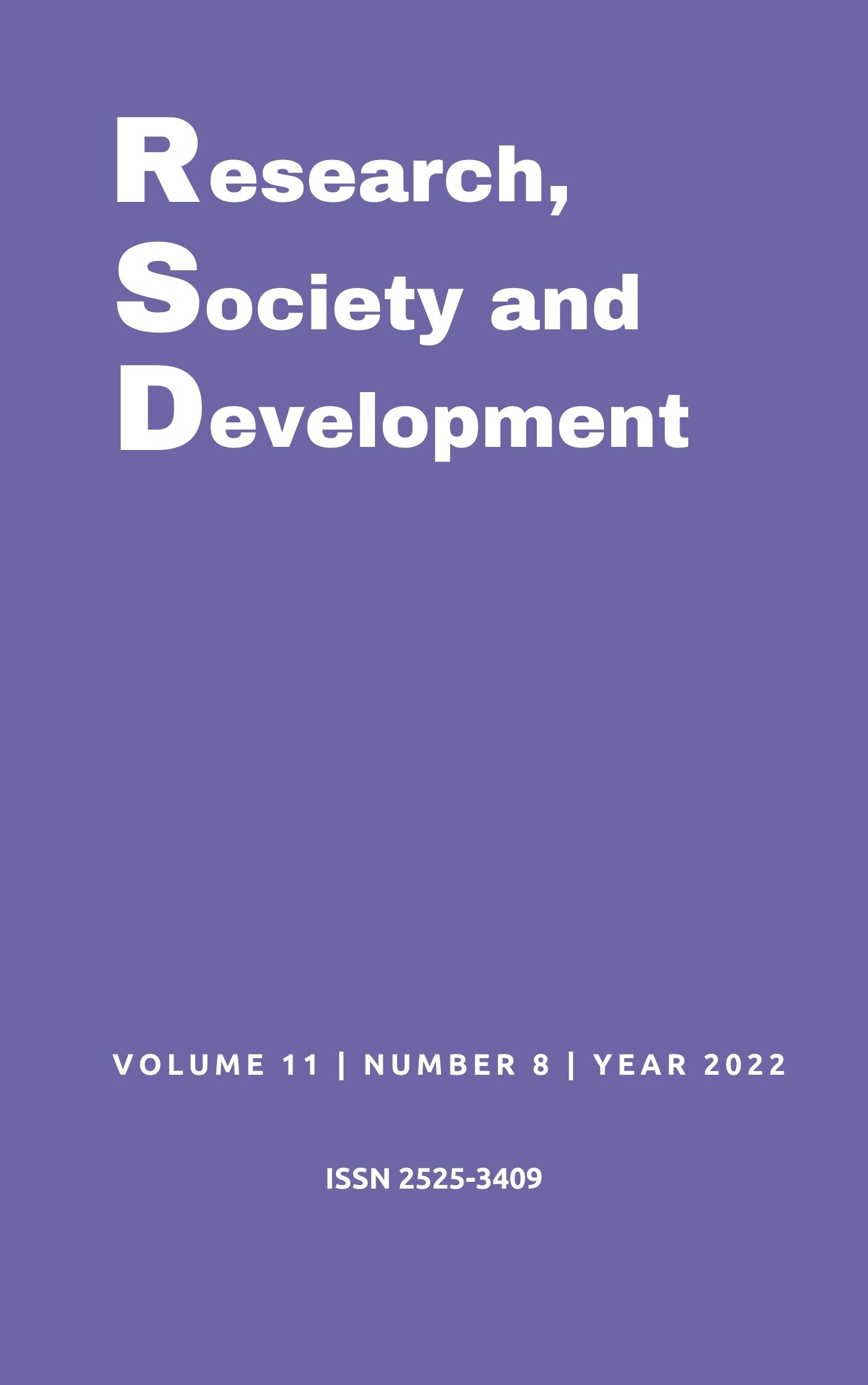Caracterização da liga de titânio Ti-6Al-4V aplicada em próteses de quadril revestidas com hidroxiapatita
DOI:
https://doi.org/10.33448/rsd-v11i8.30629Palavras-chave:
Prótese de quadril, ASTM F136, Ensaio de Fadiga.Resumo
O titânio e suas ligas são amplamente utilizados como biomateriais em substituições de tecidos duros devido a sua resposta única em contato com o ambiente fisiológico e as suas propriedades químicas e mecânicas, como resistência à corrosão, resistência à fadiga e ductilidade. Outros metais utilizados como biomateriais possuem módulo de elasticidade com valores dez vezes maiores que o osso humano, o que pode causar falhas quando há impactos. Vários estudos relatam falhas de próteses de quadril devido à fadiga. Este artigo tem como objetivo realizar estudos sobre as propriedades mecânica e resistência à fadiga em um ambiente que simule as articulações do corpo humano, utilizando próteses de quadril fabricadas com liga Ti 6Al 4V com revestimento de hidroxiapatita. As amostras foram retiradas da região do pescoço para caracterização microestrutural para identificação do tamanho de grão, inclusões, microdureza, ensaio de tração, microscopia eletrônica de varredura, espectroscopia de dispersão de energia, fluorescência de raios X e difração de raios X. Após a aplicação de mais de 10.000.000 ciclos com forças de compressão variando de -0,3 kN a -3,0 kN, não foram encontradas trincas e observou-se que a amostras sofreram apenas deformações elásticas.
Referências
Antonialli, A. Í. S., & Bolfarini, C. (2011). Numerical evaluation of reduction of stress shielding in laser coated hip prostheses. Materials Research, 14(3),331 334. https://doi.org/10.1590/s1516-14392011005000043
Bahr, R., & Krosshaug, T. (2005). Understanding injury mechanisms: a key component of preventing injuries in sport. British Journal of Sports Medicine, 39(6), 324–329. https://doi.org/10.1136/bjsm.2005.018341
Brandl, E., Leyens, C., & Palm, F. (2011). Mechanical Properties of Additive Manufactured Ti-6Al-4V Using Wire and Powder Based Processes. IOP Conference Series: Materials Science and Engineering, 26, 012004. https://doi.org/10.1088/1757-899x/26/1/012004
Cantergi, D. (2011). Avaliação das forças musculares envolvidas no exercício de extensão do quadril e joelho do método Pilates [Dissertação].
Chen, Q., & Thouas, G. A. (2015). Metallic implant biomaterials. Materials Science and Engineering: R: Reports, 87, 1–57. https://doi.org/10.1016/j.mser.2014.10.001
Costa, A. C. M. F., Lima, G. M., Lima, H. M. A., Cordeiro, V. V., Viana, K. M. S., & Souza, C. V. (2009). Hidroxiapatita: Obtenção, caracterização e aplicação. Revista Eletrônica de Materiais e Processos. http://www2.ufcg.edu.br/revista-remap/index.php/REMAP/article/view/105
Couto, A. A., Faldini, S. B., Almeida, G. F. C., Sekeres, T. S., Kunioshi, C. T., Morcelli, A. E., & Lima, N. B. (2006). Caracterização microestrutural da liga Ti-6Al-4V comercial utilizada como biomaterial.
Hodge, W. A., Fijan, R. S., Carlson, K. L., Burgess, R. G., Harris, W. H., & Mann, R. W. (1986). Contact pressures in the human hip joint measured in vivo. Proceedings of the National Academy of Sciences, 83(9), 2879–2883. https://doi.org/10.1073/pnas.83.9.2879
Kirchner, A., Klöden, B., Luft, J., Weißgärber, T., & Kieback, B. (2015). Process window for electron beam melting of Ti-6Al-4V. Powder Metallurgy, 58(4), 246–249. https://doi.org/10.1179/0032589915z.000000000244
Liu, S., & Shin, Y. C. (2019). Additive manufacturing of Ti6Al4V alloy: A review. Materials & Design, 164, 107552. https://doi.org/10.1016/j.matdes.2018.107552
Nasab, M. B., & Hassan, M. R. (2010). Metallic biomaterials of knee and hip--a review. 24 (2), 69-82. https://link.gale.com/apps/doc/A308129449/HRCA?u=googlescholar&sid=googleScholar&xid=3b4d2143
Paul, J. P. (1976). Approaches to design - Force actions transmitted by joints in the human body. Proceedings of the Royal Society of London. Series B. Biological Sciences, 192(1107), 163–172. https://doi.org/10.1098/rspb.1976.0004
Rafi, H. K., Karthik, N. V., Gong, H., Starr, T. L., & Stucker, B. E. (2013). Microstructures and Mechanical Properties of Ti6Al4V Parts Fabricated by Selective Laser Melting and Electron Beam Melting. Journal of Materials Engineering and Performance, 22(12), 3872–3883. https://doi.org/10.1007/s11665-013-0658-0
Rocha, R. C., Galdino, A. G. de S., Silva, S. N. da, & Machado, M. L. P. (2018). Surface, microstructural, and adhesion strength investigations of a bioactive hydroxyapatite-titanium oxide ceramic coating applied to Ti-6Al-4V alloys by plasma thermal spraying. Materials Research, 21(4). https://doi.org/10.1590/1980-5373-mr-2017-1144
Sidane, D., Chicot, D., Yala, S., Ziani, S., Khireddine, H., Iost, A., & Decoopman, X. (2015). Study of the mechanical behavior and corrosion resistance of hydroxyapatite sol–gel thin coatings on 316 L stainless steel pre-coated with titania film. Thin Solid Films, 593, 71–80. https://doi.org/10.1016/j.tsf.2015.09.037
Silva Junior, W. C., Souza, C. M. P. D. S., Bortoli, F. D. S., Frajuca, C., & Souza, R. C. (2021). Obtaining the predicted number of cycles of femoral prosthesis manufactured with ASTM F138 and ASTM F75 aloys, applying the method of finite element. Journal of Physics. Conference Series, 1730 (1)(012026).
Souza, C. M. P. de, Santos, R. G., Souza, R. C., Militão, V. A., Silva, I. G., Seriacopi, V., & Junior, W. C. da S. (2022). Data analyses of fatigue tests by extensometry in hip prosthesis of the Co-28Cr-6Mo alloy. Research, Society and Development, 11(4), e52011427854–e52011427854. https://doi.org/10.33448/rsd-v11i4.27854
Wang, D. G., Chen, C. Z., Ma, Q. S., Jin, Q. P., & Li, H. C. (2013). A study on in vitro and in vivo bioactivity of HA/45S5 composite films by pulsed laser deposition. Applied Surface Science, 270, 667–674. https://doi.org/10.1016/j.apsusc.2013.01.117
Downloads
Publicado
Edição
Seção
Licença
Copyright (c) 2022 Caique Movio Pereira de Souza; Vanderlei Araujo Militão; Isaias Gouveia Silva; Rene Ramos de Oliveira; Vanessa Seriacopi; Wilson Carlos da Silva Junior

Este trabalho está licenciado sob uma licença Creative Commons Attribution 4.0 International License.
Autores que publicam nesta revista concordam com os seguintes termos:
1) Autores mantém os direitos autorais e concedem à revista o direito de primeira publicação, com o trabalho simultaneamente licenciado sob a Licença Creative Commons Attribution que permite o compartilhamento do trabalho com reconhecimento da autoria e publicação inicial nesta revista.
2) Autores têm autorização para assumir contratos adicionais separadamente, para distribuição não-exclusiva da versão do trabalho publicada nesta revista (ex.: publicar em repositório institucional ou como capítulo de livro), com reconhecimento de autoria e publicação inicial nesta revista.
3) Autores têm permissão e são estimulados a publicar e distribuir seu trabalho online (ex.: em repositórios institucionais ou na sua página pessoal) a qualquer ponto antes ou durante o processo editorial, já que isso pode gerar alterações produtivas, bem como aumentar o impacto e a citação do trabalho publicado.


